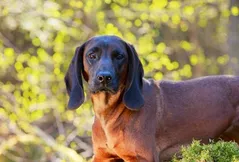
Keeshond
Keeshond stands out for the markings around his eyes that resemble eyeglasses. They are playful, loving and easygoing.
Overall Status
| Height | 17 to 18 inches at the shoulder |
| Temperament | Friendly, Lively, Outgoing |
| Weight | 35 to 45 pounds |
| Life Expectancy | 12 to 15 years |
| Coat Color | Black, Gray, Silver, White |
| Barking Level | Frequent |
Quick Factors
| Playfulness | |
| Dog Friendly | |
| Exercise Need | |
| Grooming Needs | |
| Strangers Friendly | |
| Family Affectionate |
Daily Care
Grooming Tips
The Keeshond has a long, abundant double coat with a harsh texture. There’s a lot of it, and the dogs shed heavily. The adult coat comes in when the dog is 18 months to 2 years old.Although the Keeshond’s coat looks like it might take a lot of work to maintain, it can be kept up with brushing once or twice a week — more often when he’s shedding. You’ll spend about an hour caring for the coat each week.Grooming tools to have on hand are a soft slicker brush for the cottony puppy coat, a pin brush, a stainless steelGreyhoundcomb, and a good pair of shears or scissors for trimming the hair on the feet. Ask your puppy’s breeder for advice on how to groom the dog or visit this breeder’s website for detailedgrooming tips.If you do a good job of keeping the Keeshond brushed, he shouldn’t need a bath more than two or three times a year. Whatever you do, don’t shave the coat. It serves as insulation from heat and cold.The rest is basic care. Trim the nails as needed, usually every week or two. Brush the teeth frequently with a vet-approved pet toothpaste for good overall health and fresh breath.
Exercise Tips
Keeshonden do not need a boatload of exercise daily. Inside of a fenced backyard, coupled with a family member who loves to play fetch will provide the average Keeshond with all the running time he needs to stay healthy, happy and out of trouble.Without appropriate exercise, they can become unruly and rip things apart inside of the house. Nobody wants their home destroyed, so, at the very least, a few brisk walks daily will keep your dog content.A free run or a nice walk daily will benefit them physically and mentally, and then they will be glad to climb up on the sofa with you while you read or watch TV. An essential thing to know about Kees is that they are happy dogs and will smile every day if you just spend time with them.Keep in mind that a Keeshond will be ready and raring to hop into the car to go to the park, shop at the home improvement store or select his own toys at the Pet Shop. Exercise shouldn’t be boring and repetitive. It should be spontaneous at times.
Feeding Tips
Keeshonden do best on a high-quality diet of dry kibble. Dry food helps eliminate plaque and tartar buildup which can cause cavities, gum problems and nasty doggy breath.A veterinarian or the dog’s breeder can help you to choose which food would provide the appropriate nutrition for your Keeshond.Any diet should be appropriate to the dog’s age (puppy, adult, or senior). Some dogs are prone to gettingoverweight, so watch your dog’s calorie consumption and weight level.Learn about whichhuman foodsare safe for dogs, and which are not. Check with your vet if you have any concerns about your dog’s weight or diet.Clean, fresh water should be available at all times.
Health Tips
Keeshonden are not without health issues. They are generally healthy animals however; predisposed problems can prove to be detrimental.These diseases/disorders include Addison’s disease, Hip Dysplasia, Diabetes Mellitus, Progressive Retinal Atrophy, Cataracts, Hypothyroidism, Von Willebrand’s Disease, Allergies and Epilepsy.If left untreated, some of these issues can jeopardize the life of a Keeshond. Another ailment might be problematic but with proper care, medication and treatment, a dog can live a long, fulfilling and comfortable life.
Trainability
The Keeshond is a fast learner that seems to be able to read his owner’s mind. Although they do have an independent streak, with patience and kindness, this dog can be an incredibly obedient yet still fun-loving companion.He needs an owner who is caring and gentle. Repetitive training sessions that are calm and result in the dog getting some kind of yummy reward are most successful.Harsh words and treatment will get you nowhere with this breed. They require love, kindness and easy instruction during all training sessions. Positive reinforcement will have your Keeshond the picture perfect companion.This dog can go from the home to the breed ring to the obedience in zero to sixty seconds. They also make great therapy dogs. Their adorable appearance coupled with their caring nature makes them perfect for visiting ailing kids and adults in hospitals, rehabilitation facilities and nursing bills.
History
The Keeshond (“kayz-hawnd”) is a member of the Spitz (Northern Dogs) family and is of the same stock as the German Spitz, probably being a direct descendant of the German Wolfspitz.In fact, the FCI still considers the breed a Wolfspitz. The breed has a long history of popularity with the people of Holland and was, and still is, used for a variety of jobs, including as a watchdog, for herding, for draft work and for hunting.It is also known as the “Barge Dog,” as it was customarily used on the barges as a guard and a companion. The accepted theory for the breed name is that it was named after “Kees,” the leader of the Dutch Patriot Party, for which the little dog was the mascot. The Keeshond was recognized by the AKC in 1930.






